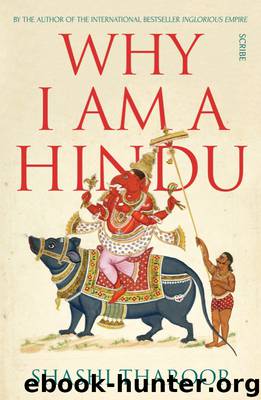Why I Am a Hindu by Shashi Tharoor

Author:Shashi Tharoor
Language: eng
Format: epub
Tags: REL032000, BIO026000, PHI034000, PHI033000, REL051000, POL000000
Publisher: Scribe Publications
Published: 2018-05-14T04:00:00+00:00
6
BEYOND HOLY COWS
THE USES AND ABUSES OF HINDU CULTURE AND HISTORY
My own faith in religious pluralism is a legacy of my upbringing in ‘secular’ India. Secularism in India did not mean irreligiousness, which even avowedly atheist parties like the communists or the southern DMK, Dravida Munnetra Kazhagam (Dravidian Progress Federation) party found unpopular amongst their voters; indeed, in Calcutta’s annual Durga Puja, the communist parties compete with each other to put up the most lavish Puja pandals (Hindu religious displays). Rather, secularism meant, in the Indian tradition, a profusion of religions, none of which was privileged by the state. I remember how, in the Calcutta neighbourhood where I lived during my high school years, the wail of the muezzin calling the Islamic faithful to prayer blended with the chant of the mantras and the tinkling of bells at the nearby Shiva temple and the crackling loudspeakers outside the Sikh gurudwara reciting verses from the Guru Granth Sahib. And just around the corner was St Paul’s Cathedral.
As we have seen, the irony is that India’s secular coexistence was paradoxically made possible by the fact that the overwhelming majority of Indians are Hindus. That acceptance of difference, which I have explored in this book and elsewhere, characterised the Hinduism propagated by Vivekananda and other visionary Hindu seers. This meant that it came naturally to Hindus to coexist with practitioners of other faiths. In a plural society, religious pluralism was merely one more kind of difference everyone accepted, just as we knew that around us were people who spoke different languages, ate different foods, dressed differently and had different shades of skin colour from ours.
SECULARISM AND SYNCRETISM
Secularism in India, therefore, did not mean separation of religion from state. Instead, secularism in India means a state that was equally indulgent of all religious groups, and favoured none.
Nor did it mean secularity in the French sense, or laïcité. The French concept keeps religion out of governmental institutions like schools and government out of religious institutions in turn, whereas Indian secularism cheerfully embraces financial support to religious schools and the persistence of ‘personal law’ for different religious communities. The Indian system has created incentives for various religious denominations to start and operate ‘minority schools’ and colleges with substantial government funding, impart religious education, and be exempt from various regulations and stipulations the Indian government imposes on non-minority institutions. (Critics, especially of the Hindutva variety, do not hesitate to point out that while government schools and colleges may not impart religious instruction, religious sects and charities affiliated to minority communities may open their own schools and receive state financial assistance even as they impart religious indoctrination.)
Under the Indian version of secularism, the government’s financial largesse is extended to the Muslim Wakf Boards, Buddhist monasteries, and certain Christian religious institutions; and under a 1951 Religious and Charitable Endowment Law, state governments are empowered to take over, own and operate Hindu temples, collect revenue from offerings and redistribute that revenue to such purposes as it deems fit, including any non-temple-related ones.
Download
This site does not store any files on its server. We only index and link to content provided by other sites. Please contact the content providers to delete copyright contents if any and email us, we'll remove relevant links or contents immediately.
Fingersmith by Sarah Waters(2409)
Kundalini by Gopi Krishna(2094)
Wheels of Life by Anodea Judith(1922)
The Bhagavad Gita by Bibek Debroy(1868)
Indian Mythology by Devdutt Pattanaik(1856)
The Yoga of Jesus: Understanding the Hidden Teachings of the Gospels by Paramahansa Yogananda(1755)
Autobiography of a Yogi (Complete Edition) by Yogananda Paramahansa(1742)
The Man from the Egg by Sudha Murty(1685)
Chakra Mantra Magick by Kadmon Baal(1589)
The Book of Secrets: 112 Meditations to Discover the Mystery Within by Osho(1589)
The Sparsholt Affair by Alan Hollinghurst(1509)
Avatar of Night by Tal Brooke(1451)
Sparks of Divinity by B. K. S. Iyengar(1450)
Karma-Yoga and Bhakti-Yoga by Swami Vivekananda(1437)
Gandhi by Ramachandra Guha(1437)
The Bhagavad Gita (Classics of Indian Spirituality) by Eknath Easwaran(1421)
The Spiritual Teaching of Ramana Maharshi by Ramana Maharshi(1373)
Hinduism: A Very Short Introduction (Very Short Introductions) by Knott Kim(1314)
Skanda Purana (Great Epics of India: Puranas Book 13) by Bibek Debroy & Dipavali Debroy(1309)
